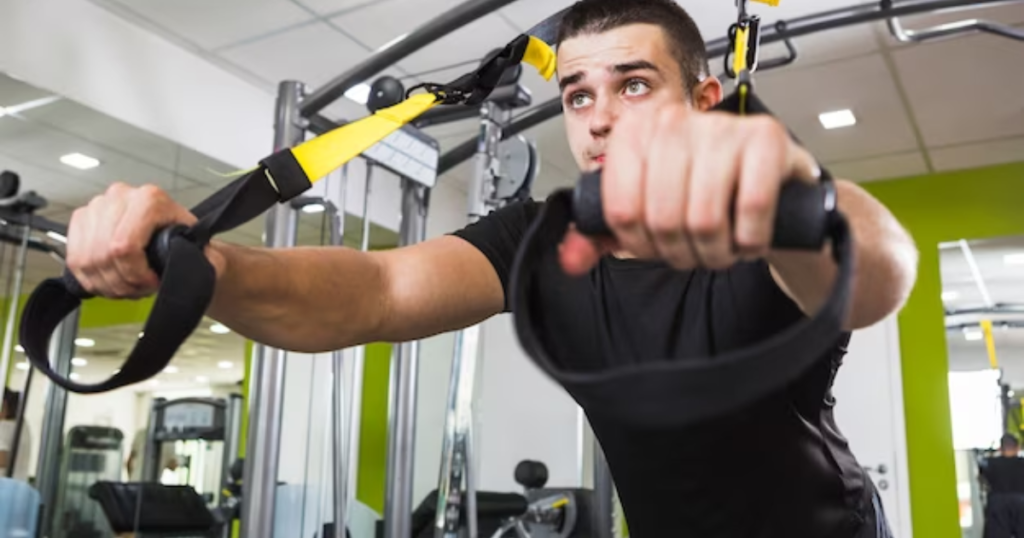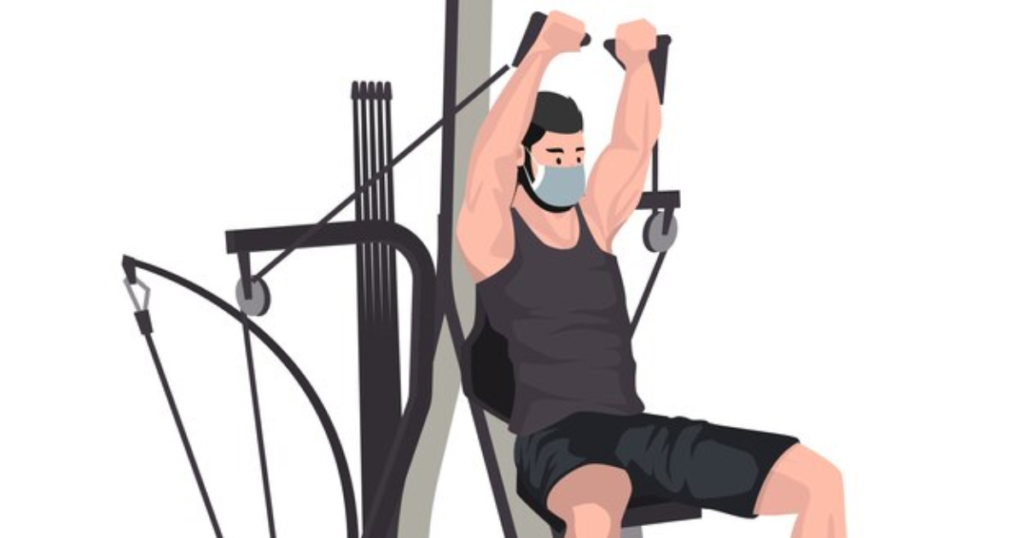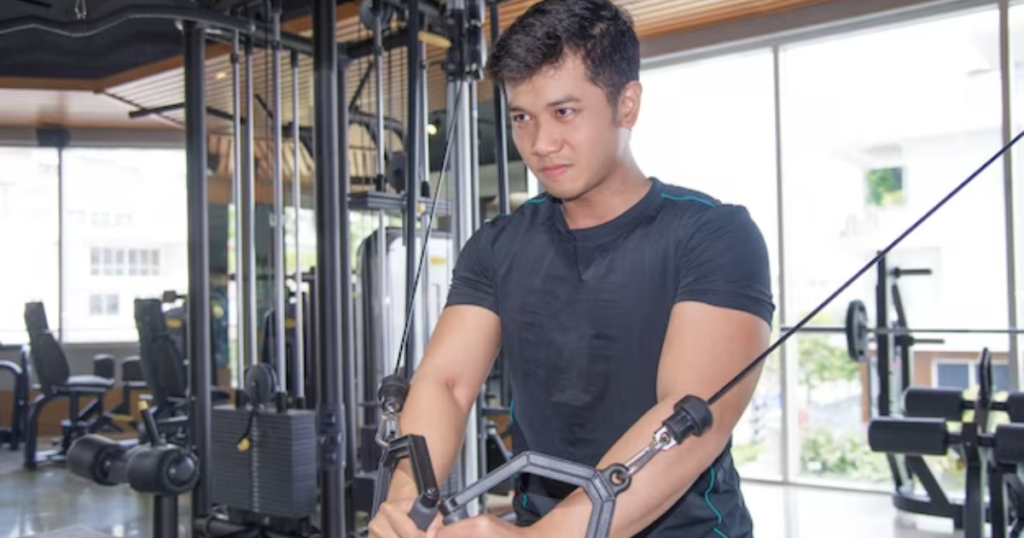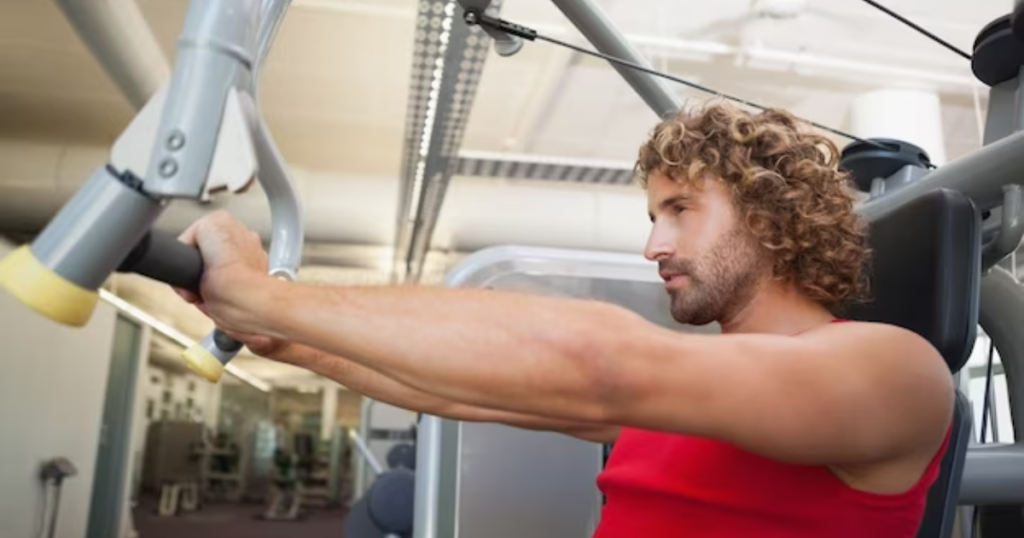If you’re looking to build a strong and defined chest, cable pec exercises are a fantastic addition to your workout routine. cable pec exercises not only target your pectoral muscles but also engage stabilizing muscles for a comprehensive upper body workout.
In this article, we’ll explore the various cable pec exercises, their benefits, proper technique, and how to incorporate them into your fitness regimen.
Benefits of Cable Pec Exercises
Cable pec exercises, which primarily target the pectoralis major muscles (pecs), have various benefits:
- Isolation: Cable pec workouts are more effective in isolating the pec muscles than free weight exercises like bench presses. With cables, you may contract and squeeze the chest muscles over their complete range of motion, resulting in improved muscle activation and growth.
- Constant Tension: Unlike certain free weight exercises, where tension varies throughout the movement, cable pec exercises maintain constant muscular tension. This constant strain can stimulate muscle growth and improve muscular endurance.
- Variety: Cable machines provide a wide range of exercises for the chest muscles, such as cable crossovers, cable flyes, and cable chest presses. This variation allows you to target different parts of the chest while avoiding plateaus in your training.
- Adjustability: Cable machines often allow for easy weight and positioning adjustments, making it easier to tailor the resistance and range of motion to your specific needs and goals.
- Joint-Friendly: Cable exercises are easier on the joints than hefty free weight exercises since they frequently entail smoother, more controlled movements. This might be especially useful for people who have joint problems or are recovering from an injury.
- Functional Strength: Cable workouts can assist build functional strength since they are more similar to real-life motions than some standard weightlifting exercises. This can lead to improved performance in activities of daily living and sport.
- Mind-Muscle Connection: Cable workouts can assist create a strong mind-muscle connection since you must actively engage and contract your chest muscles throughout the activity. This improved connection may result in better muscle activation and development over time.
- Stability and Balance: Cable exercises sometimes need more stability and balance than exercises using fixed devices or free weights. This can activate stabilizing muscles, enhancing general coordination and balance.
8 Best Chest Exercises With Cables
1. Seated Cable Chest Press
The Seated Cable Chest Press is a compound exercise that targets the chest muscles, specifically the pectoralis major, as well as the shoulders and triceps. This exercise is performed using a cable machine with a low pulley.
How to do it:
- Begin by adjusting the cable machine’s seat height so that when you sit, the handles are in line with your chest.
- Sit on the bench, back upright, feet flat on the floor. At chest level, grab the handles with an overhand hold (palms facing down).
- Engage your core muscles while keeping your shoulders relaxed.
- Exhale, then push the handles forward until your arms are fully extended in front of you. Keep your elbows slightly bent but not locked out.
- Pause briefly in the fully stretched position and concentrate on compressing your chest muscles.
- Inhale and gradually pull the handles back to your chest in a controlled motion, resisting the weight as you return to the beginning position.
- Repeat the required number of times.
- After you’ve finished your set, cautiously release the handles and get up off the bench.

Seated Incline Cable Chest Press
The Seated Incline Cable Chest Press is a great exercise for working the upper chest muscles, especially the clavicular head of the pectoralis major.
It also engages the anterior deltoids (front shoulder muscles) and triceps to varying degrees. This exercise is done on a cable machine with an adjustable bench set to an inclination setting.
How to do it:
- Adjust the cable machine bench to an incline (typically between 30 and 45 degrees). Make sure the bench is securely fastened in place.
- Sit on the bench with your back firmly against the backrest and your feet flat on the floor for support.
- At chest height, use an overhand hold (palms facing away from you) to grab the cables’ connecting handles. Your arms should be extended, with your elbows slightly bent.
- Maintain stability and perfect form by using your core muscles and lifting your chest throughout the exercise.
- Exhale and push the handles forward and upward, fully extending your arms but not locking your elbows. Squeeze your chest muscles as you push the grips away from your body.
- Pause briefly in the fully stretched position to feel the strain in your chest muscles.
- Inhale as you carefully return the grips to the beginning position, allowing your elbows to flex slightly.
- Repeat the appropriate number of times while maintaining proper form and control throughout the action.

Single-Arm Cable Chest Press
The Single-Arm Cable Chest Press is a great exercise for working the chest muscles, especially the pectoralis major, as well as the shoulders and triceps.
This exercise provides unilateral resistance, allowing you to treat muscular imbalances while focusing on each side separately.
How to do it:
- Setup: Begin by adjusting the cable machine’s pulley to the desired height, which is normally chest level. Attach one handle to the pulley.
- Positioning: Position yourself sideways to the cable machine, with your feet shoulder-width apart for support. The side closest to the machine should face away from it.
- Grip: Hold the handle with the hand on the side farthest from the machine. Your palm should be pointing downward, and your elbow should be bent at a 90° angle.
- Stance: Keep your knees slightly bent and engage your core muscles to keep your body stable during the workout.
- Execution: Exhale and push the handle forward, extending your arm in front of you with your elbow slightly bent. Squeeze your chest muscles when you reach fully extended position.
- Controlled Return: Inhale as you slowly draw the handle back towards your body while resisting the weight’s pull. Maintain tension in your chest muscles throughout the motion.
- Repeat: Finish the desired number of repetitions on one side before moving to the other. Aim for 8-12 reps per arm, depending on your fitness level and objectives.
- Symmetry: Make sure that your movements are symmetrical and balanced, with both arms functioning equally.

Standing Cable Chest Press
The Standing Cable Chest Press is a variation on the standard chest press workout that uses a cable machine with adjustable pulleys. This exercise primarily focuses the chest muscles (pectoralis major), although it also works the shoulders and triceps to a lesser extent.
How to do it:
- Adjust the cable machine’s pulleys to the desired height, which is normally around chest or shoulder level. Attach a D-handle or straight bar to both sides of the machine.
- Stand in the center of the cable machine, with your feet shoulder-width apart. Keep a firm and balanced stance throughout the workout.
- Grip the handles or bar using an overhand grip (palms down) at chest level. Your hands should be somewhat broader than shoulder width apart. You can also employ a neutral grip (palms facing each other) for diversity.
- Position your body such that your elbows are bent around 90 degrees and your upper arms are parallel to the floor. To stabilize your body, relax your shoulders and activate your core.
- Exhale while pushing the grips or bar forward in a controlled way, fully extending your arms in front of you. Concentrate on squeezing your chest muscles at the top of the movement.
- Take a brief pause in the fully extended position while keeping your chest muscles contracted. To reduce joint strain, avoid locking out your elbows.
- Inhale and slowly reverse the motion, bringing the handles or bar back to the starting position while maintaining control throughout the eccentric (lowering) phase of the movement.
- Repeat for the required amount of repetitions, which is usually 8-12 each set, depending on your fitness objectives and strength level.
- If necessary, change the weight on the cable machine to make the exercise hard yet achievable. You should be able to maintain appropriate form during each set.

Standing Incline Cable Chest Press
The Standing Incline Cable Chest Press is an excellent exercise for working the upper chest muscles (pectoralis major), anterior deltoids, and triceps. This workout is done with a cable machine with pulleys set at an inclined angle.
How to do it:
- Set up the cable machine with the pulleys at an inclined angle. When standing in front of the machine, adjust the pulley height so that it is slightly over shoulder level.
- Attach the handles to the pulleys and choose the proper weight. Begin with smaller weights to ensure appropriate form and technique.
- Face away from the cable machine, with your feet shoulder width apart. Take a step forward to apply strain to the cables.
- Grab the handles with an overhand hold (palms facing down) and raise them to shoulder height. Your elbows should be bent at a 90-degree angle, with your upper arms parallel to the floor.
- Engage your core muscles to support your body, and keep your knees slightly bent to avoid locking out.
- Exhale, then push the handles forward and upward in a controlled motion, fully extending your arms but not locking out your elbows. Squeeze your chest muscles at the apex of the movement.
- Pause briefly at the top of the movement, then inhale and carefully return the handles to their starting position, ensuring control throughout the whole range of motion.
- Repeat for the desired number of times, maintaining your chest raised and shoulders relaxed throughout the exercise.
Single-Arm Cable Incline Cable Chest Press
The Single-Arm Cable Incline Chest Press presents a variation to the conventional chest press routine, targeting the upper chest muscles, specifically the pectoralis major, simultaneously engaging the shoulders and triceps.
Executed on a cable machine featuring an adaptable incline bench and a singular handle attachment, this exercise offers a nuanced approach to sculpting and strengthening the upper body.
How to do it:
- Adjust the inclination bench on the cable machine to a comfortable angle, usually between 30 and 45 degrees. Make sure the bench is securely fastened in place.
- Attach a single handle to the cable machine’s lower pulley. When seated on the incline bench, adjust the pulley height so that it is in line with your chest.
- Sit on the incline bench, back against the pad, feet flat on the floor, core engaged for stability.
- Using your working arm (the arm closest to the cable machine), grasp the handle in an overhand grip (palm down). Your elbow should be bent 90 degrees, with your upper arm parallel to the floor and your forearm pointing forward.
- To maintain balance, position your non-working arm across your chest or on your hip.
- Exhale while keeping your core engaged and your back against the bench, then push the handle forward, extending your arm to its full length but not locking it out. Squeeze your chest muscles as you press the weight.
- Pause briefly in the fully stretched position to feel the contraction in your chest muscles.
- Inhale and slowly reverse the movement, returning the handle to your chest in a calm manner. Maintain tension in your chest muscles throughout the motion.
- Repeat the appropriate number of times on one side before moving to the opposite side.

Standing Low Cable Chest Fly (low to high)
The Standing Low Cable Chest Fly (low to high) is a great exercise for working the chest muscles, especially the pectoralis major. It also works the anterior deltoids and triceps to a lesser extent. This exercise is performed on a cable machine with the cable set to a low position.
How to do it:
- Begin by putting up the cable machine with the pulleys in the lowest position. Attach single-handle attachments to either side of the cable machine.
- Stand in the center of the cable machine, facing away from the weight stack. Position yourself so that the wires are in line with your midsection.
- Grasp the handles with an overhand grip (palms facing forward) and take one step forward for stability. Keep your elbows slightly bent throughout the workout.
- Engage your core muscles and keep your knees slightly bent. Keep your chest up, shoulders back, and spine neutral.
- Exhale gently and extend your arms forward and upward in a wide arc, keeping the elbows slightly bent. Squeeze your chest muscles and bring your hands together in front of you.
- Pause briefly at the apex of the movement, experiencing a stretch in your chest muscles.
- Inhale and slowly reverse the movement, lowering your arms back down and to the sides in a controlled motion. Maintain tension in your chest muscles throughout the motion.
- Repeat the required number of times.
Seated Low Cable Chest Fly (low to high)
The Seated Low Cable Chest Fly (low to high) is a variant on the standard chest fly exercise that works the chest muscles from a new angle. The lower and middle fibers of the chest can be efficiently engaged by executing this exercise with wires attached at a low position and pushing the grips upward.
How to do it:
- Start by adjusting the cable machine so that the pulleys are at their lowest position. Attach the handles to the cables and choose a suitable weight.
- Sit on a bench located between the cable machine pulleys. The bench should be placed far enough away from the pulleys so when you extend your arms straight out to the sides, the cables are tensioned.
- Hold the handles with an overhand grip (palms facing downward) and place your hands slightly below shoulder height.
- Sit tall with your back straight and shoulders relaxed. Engage your core muscles to keep your torso stable throughout the workout.
- Begin by putting your hands together in front of your chest and keeping your elbows slightly bent. This is the starting position.
- While keeping your elbows slightly bent, slowly open your arms out to the sides in a controlled manner. Squeeze your chest muscles when you reach fully extended position.
- At the top of the exercise, take a little pause and feel your chest muscles contract.
- Bring your hands back together in front of your chest and fight the weight as you return to the starting position.
Are Cable Exercises Good For The Chest?
Cable exercises are effective for targeting chest muscles due to their constant tension throughout the entire range of motion. They offer a variety of angles and resistance, allowing for targeted areas of the chest, including the upper, lower, and inner portions.
Cable exercises can help isolate the chest muscles and minimize involvement of other muscle groups, promoting overall muscle development and functional strength.
They also provide safety and control, reducing the risk of injury, especially for individuals with joint issues or limited range of motion. Cable machines allow for a wide variety of chest exercises, including presses, flies, crossovers, and unilateral movements, allowing for versatility in workouts.
How Do You Work Out Your Chest With Cables?
You can use cable machines to work out your chest by completing a variety of pectoral muscle-specific workouts. Here are some common cable exercises for your chest:
- Cable Chest Press: Hold the handles on the cable machine, position one foot forward, push forward until arms are fully stretched, then slowly return to original position while maintaining control.
- Cable Flyes: Position cables at chest height, stand in center, grab handles, step forward, bend elbows, and bring arms together in arc motion until chest stretch, then return slowly.
- Single Arm Cable Press: Set the cable to chest height and stand facing away from the machine. Grab the handle with one hand and move it across your body to the opposite shoulder. Press the handle forward until your arm is completely stretched, then return to the starting position.
- Cable Crossovers: Adjust the cables to the highest point on the machine. Grab the handles with an overhand grip and take one step forward. Swing your arms down and across your body in a sweeping motion, crossing them in front of you. Keep your elbows slightly bent throughout the exercise.
- Incline Cable Press: Lower the cables and set up an incline bench facing away from the machine. Lie back on the bench, grip the handles, and press them forward until your arms are fully extended. Slowly return to your starting location.
- Decline Cable Press: Position the cables high and set up a decline bench facing away from the machine. Lie back on the bench, grip the handles, and press them down until your arms are fully extended. Slowly return to your starting location.
When completing these exercises, remember to maintain perfect form, regulate the movement, and squeeze your chest muscles at the peak of contraction.
Equipment Needed for Cable Pec Exercises
The equipment required for pec exercises varies depending on whatever exercises you undertake. Below is a list of common equipment used for pec exercises:
- Cable Machines: Cable machines are adaptable pieces of equipment that may be used for a variety of chest workouts, including cable chest presses, cable flyes, and crossovers.
- Dumbbells: Dumbbells are required for a variety of chest workouts, including dumbbell bench press, dumbbell flyes, and incline/decline dumbbell press.
- Barbell: Exercises with a barbell include the barbell bench press, incline/decline barbell bench press, and barbell chest press variations.
- Bench: To do bench press movements, you need a solid bench. Depending on the exercise variant, it may be flat, inclined, or declining.
- Weight Plates: Weight plates are used to increase resistance on barbells and machines, allowing you to gradually stress the chest muscles.
- Resistance Bands: Resistance bands can be used instead of wires to do exercises such as resistant push-ups, chest flyes, and chest presses.
- Smith Machine: The Smith machine can be used to do workouts such as Smith machine bench press and incline/decline Smith machine bench press.
- Medicine Ball: To add diversity to your chest workout, try movements like medicine ball chest passes and medicine ball push-ups.
- Medicine Ball: Push-up bars or handles can improve range of motion and wrist comfort during push-up versions that focus the chest muscles.
- Suspension Trainer (e.g., TRX): Suspension trainers, such as TRX, can be used for suspended push-ups, chest flyes, and other bodyweight exercises that work the chest muscles.
You may construct an effective chest training plan using these alternatives based on your tastes, goals, and equipment availability. Always warm up and cool down before and after your workouts.
Proper Form and Technique
Cable machines offer a versatile range of exercises for targeting the pecs (pectoral muscles). Here are several variations of cable pec exercises:
- Cable Chest Press:
- Stand in front of the cable machine, with the pulleys set to around shoulder height.
- Grab the handles and take a step forward to create tension in the wires.
- Press the handles forward until your arms are fully extended in front of you, then slowly return to their original position.
- Cable Chest Fly:
- Set the pulleys to their highest position.
- Stand in the center of the cable machine, holding the handles.
- Step forward slightly with one foot to provide support.
- Perform a wide arc motion with your arms together in front of your chest, keeping your elbows slightly bent, and then return to the starting position.
- Single-Arm Cable Chest Press:
- Adjust one pulley to a lower setting.
- Stand perpendicular to the cable machine, with the pulley at your side.
- Grab the handle with one hand and take a short step forward.
- Press the handle forward until your arm is fully stretched, then return to the starting position.
- Single-Arm Cable Chest Fly:
- Adjust one pulley to a lower setting.
- Stand perpendicular to the cable machine, with the pulley at your side.
- Grab the handle with one hand and take a short step forward.
- Perform a wide arc motion with a slight elbow bend, then return to the starting position.
- Low Cable Crossover:
- Set the pulleys to their lowest setting.
- Stand in the center of the cable machine, holding a handle in each hand.
- Step forward slightly and lean forward from your hips.
- Pull the handles together in front of your body, gently crossing them over at the height of the movement, and then return to the starting position.
Variations of Cable Pec Exercises
Certainly! Cable machines provide a variety of exercises to target the pectoral muscles. Below are some variants of cable pec exercises:
Cable Chest Press:
- Stand facing away from the cable machine, with the handles at chest height.
- Grasp the handles and push forward until your arms are completely extended.
- Slowly return the handles to the starting position.
Cable Chest Fly:
- Set the cables at shoulder height.
- Stand between the pulleys, holding the handles with your arms extended.
- Bring your hands together in a wide arc motion before returning to the beginning position.
Single-arm Cable Chest Press:
- Adjust one pulley to a lower setting.
- Stand sideways to the cable machine, grasp the handle with one hand, and step back to produce tension.
- Press the handle forward until your arm is completely stretched, then return to the starting position.
Single-Arm Cable Chest Fly:
- Adjust one pulley to a lower setting.
- Stand sideways to the cable machine, grab the handle with one hand, and step back to produce tension.
- Bring your arm around your body in a wide arc motion before returning to the starting position.
Low-to-high cable crossover:
- Set the pulleys to their lowest setting.
- Stand in the center of the cable machine, holding a handle in each hand.
- Pull the handles up and together in front of your body, crossing them slightly at the top, and then return to the starting position.
High-Low Cable Crossover:
- Set the pulleys to their highest position.
- Stand in the center of the cable machine, holding a handle in each hand.
- Pull the handles down and together in front of your body, crossing them slightly at the bottom, and then return to the beginning position.
Common Mistakes to Avoid for Pec Exercises
When completing pec exercises, it is critical to prevent common errors that can result in poor workouts or even injury. Here are some common mistakes you should avoid:
- Using overly Much Weight: Overly heavy weights can impair form and increase injury risk. Choose a weight that allows perfect form retention and control during repetitions.
- Improper Form: Incorrect form, such as arching the back, flaring the elbows, and using momentum, can reduce exercise effectiveness and increase injury risk.
- Not Using a Full Range of Motion: Common mistakes in PE workouts include not using the entire range of motion, extending arms fully, or placing weights too close together.
- Neglecting Warm-Up: Using a dynamic warm-up before each workout can significantly improve muscle preparation, blood flow, and flexibility, reducing the risk of injury and enhancing workout performance.
- Overlooking Muscle Activation: Failure to correctly activate the chest muscles before beginning a workout can cause other muscle groups to compensate and take over the activity. Before commencing pec workouts, mentally connect with your chest muscles and conduct activation exercises if needed.
- Ignoring muscular Imbalances: Failure to correct muscular imbalances can result in uneven development and increases the risk of injury. Unilateral movements, like as single-arm presses or flyes, can help discover and fix muscular imbalances between the left and right sides of the body.
- Lack of Variation: Repeating the same workouts without adding variation can lead to plateaus and stymie growth. Include a variety of chest exercises in your workout program to target different parts of the chest and avoid boredom.
Read More: Single Arm Tricep Pull Down
Conclusion
Cable pec exercises are a versatile and effective approach to build and tone your chest muscles. By combining appropriate form, technique, and variations into your training regimen, you can produce outstanding results and advance your chest development to the next level.
Frequently Asked Questions
What are cable pec exercises?
Cable pec exercises are workouts that target your chest muscles using special machines with adjustable cables. These exercises help strengthen and tone your chest muscles, giving you a more defined chest.
How do I do cable pec exercises?
To initiate cable pec exercises, position yourself in front of the cable machine, ensuring one foot is placed in front of the other. Proceed by firmly grasping the handles affixed to the cables. Next, commence by pulling the handles towards each other in front of your body, while conscientiously contracting your chest muscles. Gradually release the tension and proceed to repeat this motion for the designated number of repetitions.
Are cable pec exercises good for building chest muscles?
Indeed, cable pec exercises are excellent for developing chest muscles. This is due to the fact that they offer consistent tension throughout the movement, thereby facilitating muscle growth stimulation. Furthermore, they enable a broad spectrum of motion, effectively targeting various regions of the chest.
Can I do cable pec exercises at home?
While it’s ideal to do cable pec exercises at a gym where you have access to the proper equipment, there are alternatives you can do at home. You can use resistance bands attached to a door frame or invest in a home cable machine if you have the space and budget for it.
How often should I do cable pec exercises?
It’s recommended to incorporate cable pec exercises into your regular workout routine about two to three times a week, with at least a day of rest in between sessions to allow your muscles to recover and grow. Remember to start with a weight that challenges you but allows you to maintain proper form.









Leave a Reply